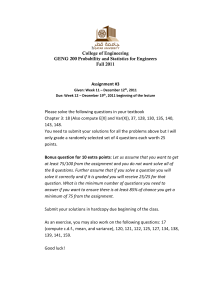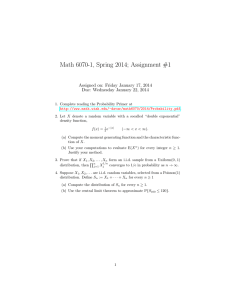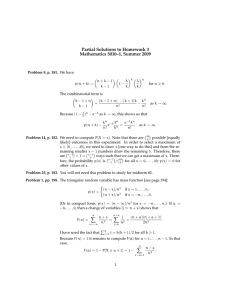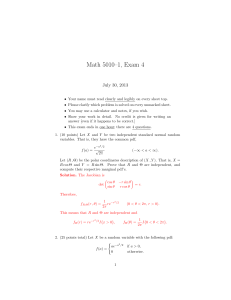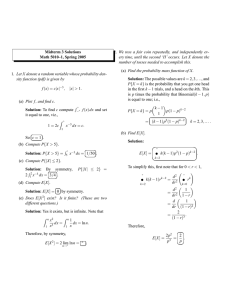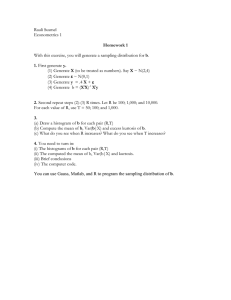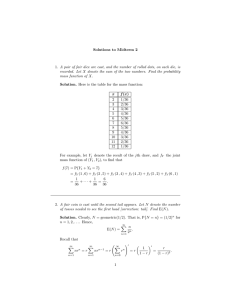Partial Solutions to Homework 5 Mathematics 5010–1, Summer 2009
advertisement
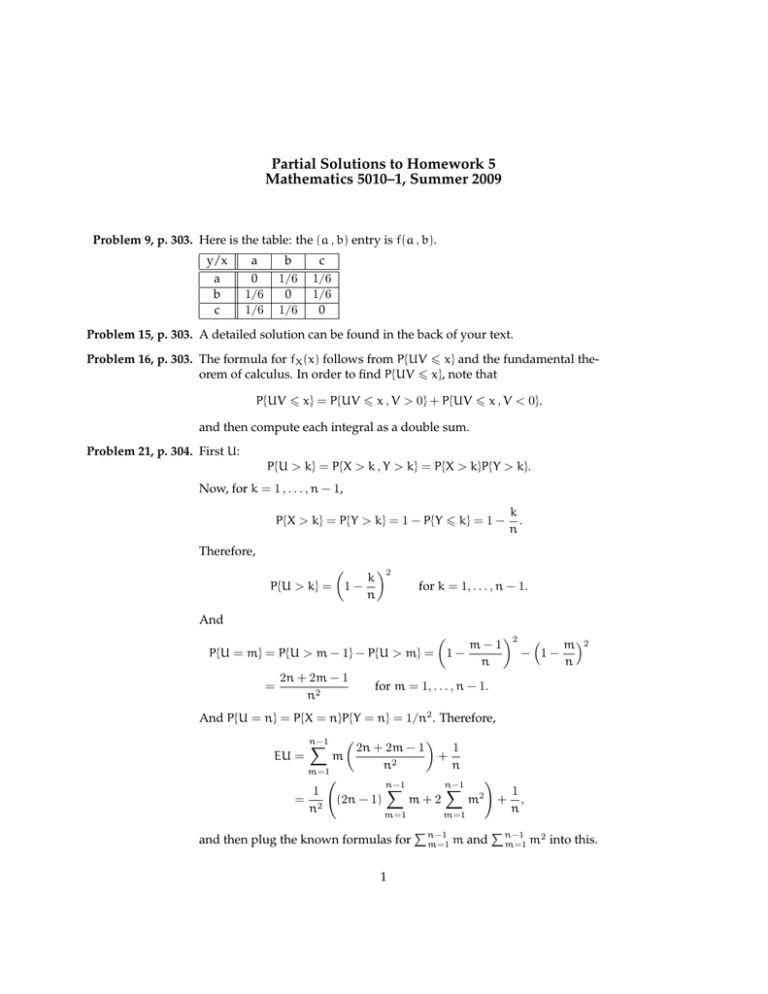
Partial Solutions to Homework 5
Mathematics 5010–1, Summer 2009
Problem 9, p. 303. Here is the table: the (a , b) entry is f(a , b).
y/x
a
b
c
a
0
1/6
1/6
b
1/6
0
1/6
c
1/6
1/6
0
Problem 15, p. 303. A detailed solution can be found in the back of your text.
Problem 16, p. 303. The formula for fX (x) follows from P{UV 6 x} and the fundamental theorem of calculus. In order to find P{UV 6 x}, note that
P{UV 6 x} = P{UV 6 x , V > 0} + P{UV 6 x , V < 0},
and then compute each integral as a double sum.
Problem 21, p. 304. First U:
P{U > k} = P{X > k , Y > k} = P{X > k}P{Y > k}.
Now, for k = 1 , . . . , n − 1,
P{X > k} = P{Y > k} = 1 − P{Y 6 k} = 1 −
k
.
n
Therefore,
P{U > k} =
2
k
1−
n
for k = 1, . . . , n − 1.
And
P{U = m} = P{U > m − 1} − P{U > m} =
=
2n + 2m − 1
n2
2 m−1
m 2
1−
− 1−
n
n
for m = 1, . . . , n − 1.
And P{U = n} = P{X = n}P{Y = n} = 1/n2 . Therefore,
EU =
n−1
X
m=1
1
= 2
n
m
2n + 2m − 1
n2
(2n − 1)
n−1
X
+
m+2
m=1
and then plug the known formulas for
1
1
n
n−1
X
!
m2
m=1
Pn−1
m=1
m and
+
1
,
n
Pn−1
m=1
m2 into this.
To compute E(U2 )—and hence var(U)—we do the same thing as above,
but start with
n−1
X
2n + 2m − 1
E(U2 ) =
m2
+ 1.
n2
m=1
The other computations are similar, but we need P{V = k}. That is computed slightly differently: For all k = 1, . . . , n,
P{V 6 k} = P{X 6 k}P{Y 6 k} =
2
k
.
n
Therefore,
P{V = k} = P{V 6 k} − P{V 6 k − 1} =
2
2 k−1
2k − 1
k
−
=
.
n
n
n2
Now we can proceed as before.
Problem 24, p. 304. First we need FY . If a 6 0 then FY (a) = 0. If a > 0, then
FY (a) = P eX 6 a = P {X 6 ln a} = FX (ln a).
Therefore, fY (a) = 0 if a 6 0 and
2
fX (ln a)
e−(ln a) /2
√
fY (a) =
=
a
a 2π
if a > 0.
In particular,
Z∞
E(Y) =
0
Z∞
2
e−(ln a)
√
2π
=
−∞
Z∞
/2
2
e−z /2 ez
√
da =
dz
2π
−∞
Z ∞ − 1 (z2 −2z+1)
1
2
e− 2 (z −2z)
e 2
√
√
dz = e1/2
dz.
2π
2π
−∞
We have been completing the square. Now change variables one more
time:
Z ∞ − 1 w2
e 2
√
E(Y) = e1/2
dw = e1/2 .
2π
−∞
Similarly,
E(Y 2 ) =
Z∞
0
Z∞
=
0
Z ∞ 2z −z2 /2
2
ae−(ln a) /2
e e
√
√
da =
dz
2π
2π
0
Z ∞ − 1 (z−2)2
1
2
e 2
e− 2 (z −4z)
2
√
√
dz = e
dz = e2 .
2π
2π
0
Therefore, var(Y) = e2 − e = e(e − 1).
2
Problem 25, p. 305. First, we note that [logically speaking], N > n means that X0 = max(X1 , . . . , Xn−1 ).
Therefore,
P{N > n} = P {X0 > X1 , · · · , X0 > Xn−1 } > P {X0 > X1 , · · · , X0 > Xn−1 } .
Let Aj denote the event that Xj is the unique maximum among X0 , . . . , Xn−1 .
Note that: (i) Aj ’s are disjoint; and (ii) P(A0 ) = P(A1 ) = . . . = P(An−1 ).
Because P(A0 ) + · · · + P(An−1 ) = P(A1 ∪ · · · ∪ An−1 ) = 1, this shows that
P(A0 ) = 1/n. And therefore, P{N > n} > n−1 .
3
